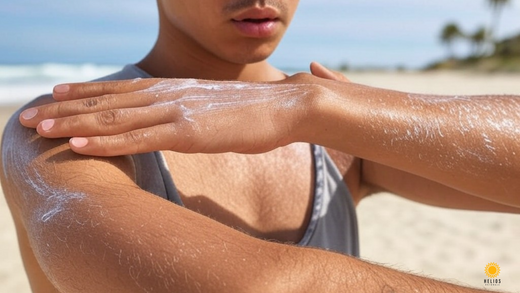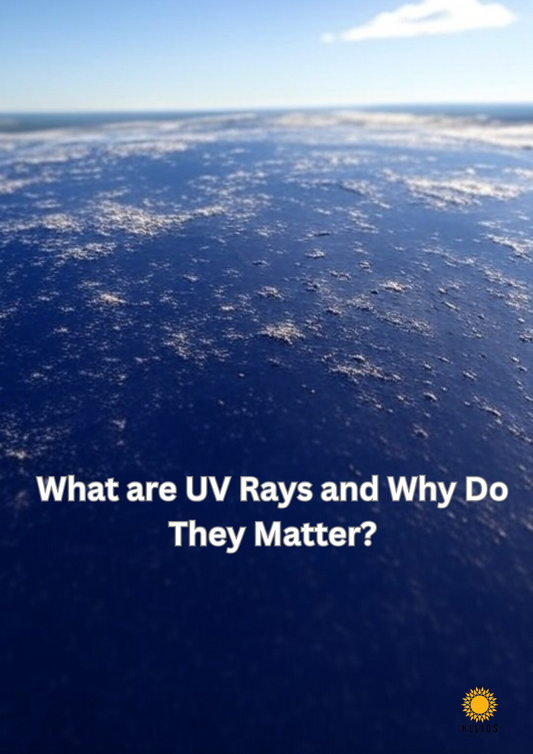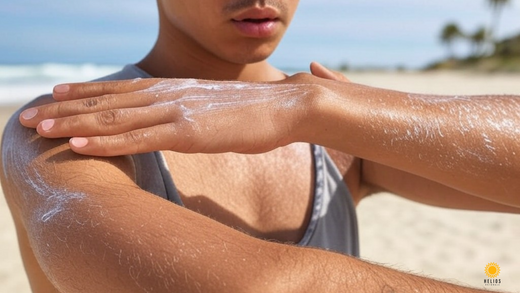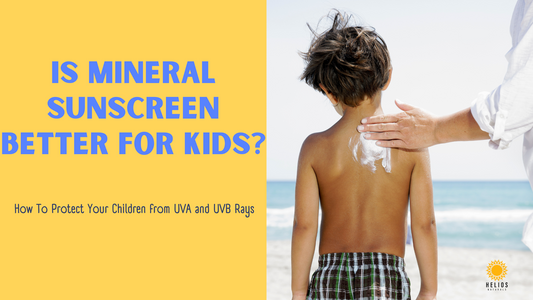
What is Chemical Sunscreen?
Share
A chemical sunscreen is a type of sunscreen that absorbs UV rays and converts them into heat to protect the skin.
Chemical sunscreens have been under fire recently by many people for the environmental harm and endocrine disrupting ingredients. Typically these active ingredients are the following: avobenzone, oxybenzone, octinoxate, octocrylene, octisalate, or homosalate.
There are two main types of sunscreens, chemical and mineral sunscreens both have different purposes. Mineral sunscreens are also called physical sunscreens, they create a physical barrier for sun protection.
In this post, we’ll discuss what chemical sunscreen uses, and potential drawbacks.
How Does Chemical Sunscreen Work?
Chemical sunscreen works by using active ingredients to absorb UV radiation and transform it into heat, preventing skin damage.
The active ingredients absorb the UV rays and prevent them from penetrating deeper in the skin where they can cause damage. The UV radiation hits the skin, these molecules undergo a photochemical reaction.
The UV energy excites electrons in the sunscreen molecules to a higher energy state, once they return to their ground state, the absorbed energy is released.T his prevents the UV rays from interacting with the DNA and cellular components, which could lead to cancer, oxidative stress, and skin aging.
For context, mineral sunscreens, the other type of sunscreen, provide sun protection by reflecting UV rays by providing a physical barrier. Chemical sunscreens require 15 minutes in the shade before sun exposures, unlike mineral sunscreens they work immediately.
What Are the Active Ingredients in Chemical Sunscreen?
Active ingredients in chemical sunscreens include oxybenzone, avobenzone, octinoxate, and homosalate.
Oxybenzone, avobenzone, octinoxate, and homosalate are just a few common chemical UV filters in sunscreens. Oxybenzone absorbs UVB and short-wave UVA, potentially disrupting hormones and harming coral reefs. Avobenzone protects against longer UVA rays but can degrade under sunlight, often stabilized with octocrylene. Octinoxate absorbs UVB, with concerns about endocrine disruption and environmental damage. Homosalate also targets UVB, raising similar health and ecological issues.
Each active chemical converts UV rays light into heat, but their use is scrutinized due to absorption into the body and environmental impact. If you’re concerned about the use of chemicals in your sunscreen, you should instead select a mineral sunscreen.
How Is Chemical Sunscreen Different from Mineral Sunscreen?
Chemical sunscreen absorbs UV rays and turns them into heat, while mineral sunscreen reflects them.
|
Aspect |
Mineral |
Chemical |
|
Absorption |
Does not absorb into skin Sits on surface of skin and works immediately upon application |
Absorbs into skin 15-20 minute absorption time to begin working |
|
Reflection |
Reflect or scatters UV rays Contains physical blockers like zinc and titanium oxide |
Absorbs UV rays, converts them into heat, then releasing to heat into the skin Does not reflect UV light but uses chemical reactions |
|
Environmental Impact |
Generally considered safe for marine life Biodegradable |
Ingredients are linked to coral reef damage and are banned in many island communities Less biodegradable Poses risks to marine life |
|
Skin Compatibility |
Non-comedogenic Leaves a white cast, especially on darker skin tones Less likely to irritate or cause allergic reactions |
More likely to cause irritation Often formulated to be invisible on all skin tones Some can be comedogenic, potentially clogging pores |
Both types of sunscreen offer great sun protection but the key difference is chemical sunscreen has more potential hazards for the environment and are more likely to cause irritation and clog pores.
What Are the Pros of Using Chemical Sunscreen?
The benefits of chemical sunscreen include its lightweight texture, easy absorption, and broad-spectrum protection.
Chemical sunscreens are definitely more aesthetically pleasing because they do not sit on top of the skin. Mineral sunscreens can look like paint on the skin and can be difficult to apply evenly. In addition to the aesthetics, it’s more common to find chemical sunscreens on the shelf because they’re more popular.
Chemical sunscreens are ideally used if you are away from the ocean and you need sun protection while outside at an event or in a city where you don’t want people to see the white cast from a mineral sunscreen.
What Are the Cons of Using Chemical Sunscreen?
The downsides of chemical sunscreen include potential skin irritation, endocrine disruption risks, and harm to marine life.
According to the NIH, there is substantial evidence that common chemicals like oxybenzone and octinoxate can mimic estrogen and interfere with testosterone production. Another issue is these chemicals can linger in the body for weeks after application with urine, blood, semen, and even in breast milk for nursing mothers.
Although more research is needed to determine long-term effects, there is concern on how chemical sunscreens impact reproductive hormone levels, pubertal functions, thyroid, and immune system.
In addition to human health concerns, their toxic effects on coral reefs have raised the alarms in many island communities who want to protect their marine wildlife and beautiful coral beaches. In NOAA’s report on Skincare Chemicals and Marine life, chemical sunscreens can impair algae growth, cause defects in mussels, sea urchins, and make fish infertile.
The sunscreen you put on your skin does not always stay on your skin so it’s important to be mindful of where you are when you apply chemical sunscreen because it can have damaging effects for the planet.
How to Apply Chemical Sunscreen Properly?
Apply chemical sunscreen 15–20 minutes before sun exposure to allow it to be fully absorbed into the skin.
- Apply indoors or in the shade
- Start with a small amount on forgotten areas ears, back of the neck, nose
- Next work on larger body parts using more sunscreen
- Make sure the SPF is 30 or higher
- Wait 15-20 minutes before going outside to allow the chemical absorb into your skin
If you’re going in and out of the water, make sure to reapply sunscreen each time, ideally under an umbrella to allow the chemicals to sit in your skin.
Is Chemical Sunscreen Safe for Sensitive Skin?
Chemical sunscreens are not suitable for sensitive skin due to potential irritation from certain ingredients.
If you have sensitive skin, you may want to opt for a mineral sunscreen since it doesn’t contain active ingredients that come from chemicals, instead it comes from minerals like non-nano zinc oxide and titanium dioxide. Chemical sunscreens are not ideal for those with sensitive skin.
If you do not like the appearance of mineral sunscreen on your skin, you can get a patch test from a dermatologist to find out what chemicals irritate your skin. However, some mineral sunscreens have a clear or skin matching tone formula where you cannot notice it on the skin.
How Does Chemical Sunscreen Affect the Environment?
Some chemical sunscreens harm marine ecosystems by causing coral bleaching and disrupting aquatic life.
Chemical sunscreens typically contain oxybenzone, octinoxate, nano-titanium, benzophenone, O-PABA, and nano-zinc oxide, just to name a few. These ingredients can decrease fertility and reproduction and fish and deform juvenile fish.
According to People 4 Ocean, the following holiday destinations have banned chemical sunscreens:
- Hawaii
- Key West, Florida
- US Virgin Islands
- Aruba
- Mexico
If you end up in these locations, then you should bring mineral sunscreen. If you forget to pack your sunscreen, mineral sunscreens are the only sunscreens reef-safe sunscreens that will be sold in these locations anyway.
What Should You Look for When Choosing a Chemical Sunscreen?
When selecting a chemical sunscreen, prioritize broad-spectrum protection and avoid harmful ingredients like oxybenzone.
Sun protection factor (SPF) is important to look for when selecting a chemical sunscreen. A common misconception is the SPF number coincides with how many minutes you can stay outside, this is false. SPF measures the amount of UV radiation your skin can tolerate before it begins to burn. A high SPF correlates with being able to withstand longer amounts outside but it’s not a fixed amount of time because the UV index changes throughout the day.
Most people fall into a few buckets of skin profile that are compatible with certain products, there’s normal, oily skin, dry skin, and combination skin. It’s rare to have “normal skin” so most people have dry, oily or combination skin. It’s also worth noting, those with sensitive skin generally cannot tolerate chemical sunscreens due to skin irritation, if you’re unsure try a patch test.
For example, those with oily skin should search for non-comedogenic formulas so they don’t break out. People with dry skins should find a chemical sunscreen that has a moisturizing ingredient or cream based formula to keep the skin hydrated. If you have a combination skin profile, it’s important to find a formula that’s lightweight, hydrating and non-comedogenic.
Are There Alternatives to Chemical Sunscreen?
Alternatives to chemical sunscreen include mineral sunscreens and sun-protective clothing.
The best alternative is sun protective clothing because you don’t have to reapply, it’s a physical barrier between you and the sun. You can easily see and feel which areas of your body are unprotected, unlike chemical sunscreens that rub in.
Mineral sunscreens are another good alternative but are best used in tandem with sun protective clothing because they can cover the areas that clothing cannot. Unless you go outside in a ninja costume, which we wouldn’t recommend on a hot sunny day.
Again, mineral sunscreens are great because they create a physical barrier on the skin and have minimal environmental and endocrine impact, unlike chemical sunscreens.
FAQs About Chemical Sunscreen
Can chemical sunscreen cause acne?
Yes, chemical sunscreens can raise your risk of acne. However, the right chemical sunscreen that matches your skin profile can help. Also some chemical sunscreens are non-comedogenic.
What is the shelf life of chemical sunscreen?
According to the FDA, it’s 3 years after the manufactured date.
Can I mix chemical and mineral sunscreens?
No. Just because you can doesn’t mean you should, there’s less
How Do I Store Chemical Sunscreens?
To maintain their effectiveness, it’s best to store them in a cool dark place.
Is Chemical Sunscreen Right for You?
Chemical sunscreens are the most common type of sunscreen on the aisles but it certainly has its drawbacks with marine wildlife and potential long term side effects.
Assuming mineral sunscreens and the white cast they leave on your face are an absolute no go for you then chemical sunscreen can be a good option for you. Just keep in mind if you go on vacation and decide to go snorkeling, you should not wear it and opt for sun protective clothing instead.
If you’re not sold on chemical sunscreens, give Helios a try. It’s a mineral sunscreen designed to give you long lasting sun protection without the harmful effects of chemical sunscreen.



